CRJ 13:1 Out now
CRJ 13:1, published in October, presents initial reports on Hurricanes Harvey, Irma and Maria. Emily Hough interviews Jesper Holmer Lund of the International Search and Rescue Advisory Group, and we take a look at humanitarian initiatives and why public trust in NGOs is declining. Christo Motz interviews Hassan Zubier, the off-duty paramedic who tried to save a badly injured woman in the Turku terrorist stabbing attack in Finland, before we move onto climate, security and terrorism, including a look at how to reintegrate returning foreign fighters and their children.
On the business continuity and resilience front, this issue looks at how to keep personnel safe when they travel to dangerous parts of the world and what to do if something goes wrong; we also examine national resilience in times of crisis, the qualities leaders need in emergencies or crises and how to put together a battle box to keep a business viable after a disaster. Elliott Atkins looks at cyber technology and Ben Duncan analyses examples of risk communication in health emergencies. Our R&D team present exciting possibilities in the treatment of brain injury, before we move onto multi-agency co-operation and projects that look at bringing police and communities closer together, along with immersive counter-terror training. Read below for a full summary.
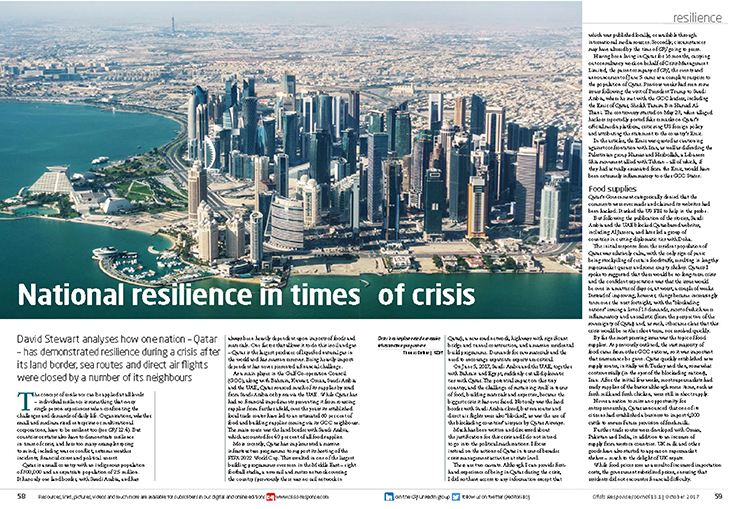
David Stewart examines how the state of Qatar has shown resilience during a blockade by its neighbouring countries
Disasters: Natural, man-made or both?
Editorial Advisory Panel Member SK Dogra contends that a new category of disaster should be adopted, to reflect how the consequences of climate and nature are compounded by human action.
Averting catastrophes in high-rise fires
Anna Averkiou speaks to the management team of Dubai’s Torch Tower to find out how all occupants were safely evacuated and provided with emergency assistance when fire broke out on the 62nd floor.
Hurricanes Harvey and Maria on the US mainland
Over a period of two-and-a-half weeks during late August and early September, the US faced the onslaught of two Category 4 hurricanes that devastated the states of Texas and Florida, reports Editorial Advisory Panel Member Bill Peterson.
Hurricanes: A Caribbean update
This year’s unusually active and destructive hurricane season has laid waste to many islands, reports Emily Hough with a short summary of the islands affected and a brief insight into the initial response.
Improving urban search and rescue operations
The International Search and Rescue Advisory Group’s (INSARAG) experience dates back to more than 25 years and is a perpetual evolution in terms of lessons learnt. It is now helping to share this knowledge with other humanitarian clusters, Jesper Holmer Lund tells Emily Hough in this interview.
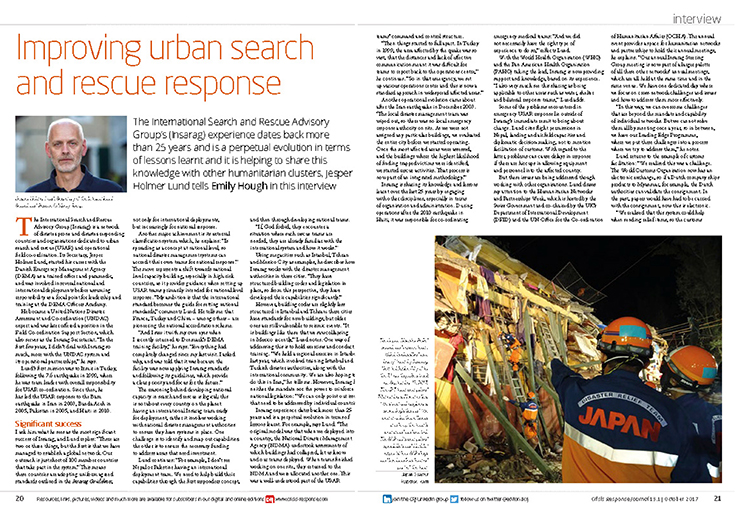
Emily Hough learns about INSARAG's developments and plans for the future
Humanitarian aid: It’s a matter of trust
When the need for ever greater humanitarian action is required in so many parts of the world, why is interest in helping others so increasingly reticent? Anastasia Kyriacou of Aidex investigates how trust in NGOs is declining in many countries.
Clean water for an entire nation
Most would say the goal of giving clean water to every household in Liberia by December 2020 is an impossible task. But when a company and an NGO combine their efforts with resources, a plan of execution, local capacity building and the data to prove it, this impossibility is becoming reality, explains Darrel Larson of Sawyer International.
Surviving a terrorist attack: A paramedic’s tale
In August, an asylum seeker attacked ten people in the Finnish town of Turku. Christo Motz speaks to paramedic Hassan Zubier, who was stabbed several times as he tried to save the life of a fatally injured young woman.
Geopolitical threats, vulnerabilities and climate
We must place climate change and resource scarcity to the conventional considerations of national security before time runs out, contends Casey Brunelle.
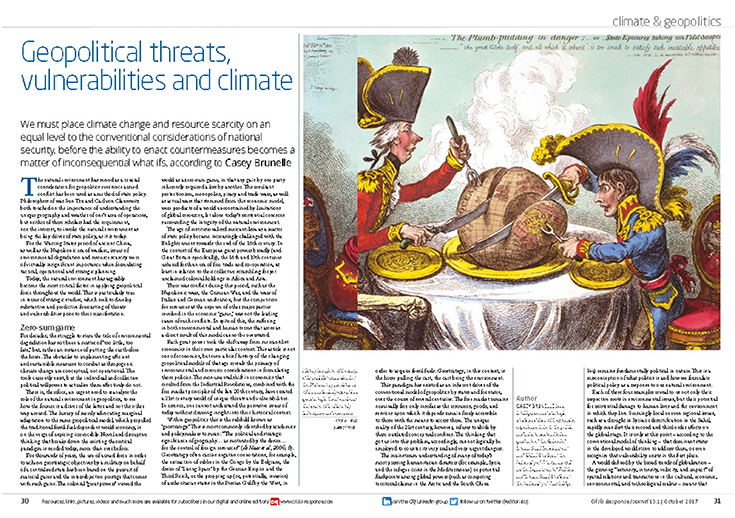
Casey Brunelle writes about tackling climate change and resource scarcity
Stabilisation in Iraq
Conflict in one region has a habit of spilling out into others, with a myriad of tragic consequences, says John Drake.
Protracted armed conflicts: How do we respond?
Long-lasting conflicts are not new, but today’s protracted wars have features specific to our times. And their impact upon civilians is amplified in population centres and urban areas, writes Thierry Meyrat of the ICRC.
Refugees fleeing explosive violence: Europe’s response
The rising use of explosive weapons around the world – particularly in ongoing conflicts in Syria, Iraq, Yemen and Afghanistan – has had deep and terrible consequences, says Jennifer Dathan of AOAV. But how are governments in Europe responding to help those who have suffered the effects of explosive violence?
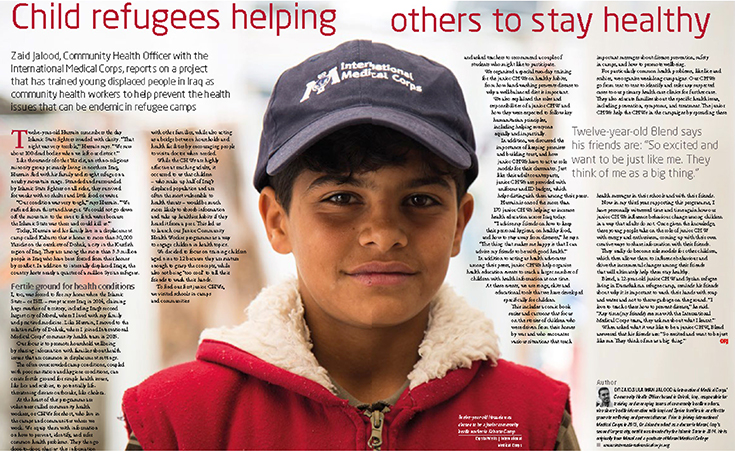
Junior health volunteers in refugee camps, by Dr Zaid Jalood
Child refugees helping others to stay healthy
Dr Zaid Jalood of the International Medical Corps, reports on a project that has trained young displaced people in Iraq as community health workers to help prevent the health issues that can be endemic in refugee camps.
How to reintegrate juvenile violent offenders?
Children in so-called Islamic State territories play an important role in the organisation and are also used for suicide attacks, executions and fighting, say Liesbeth van der Heide and Jip Geenen. If they can be viewed not only as perpetrators, but also as victims, can they be reintegrated into society?
Dangerous homecoming: IS deportees and returnees
How do you reintegrate people who joined Islamic State back into their communities when they return home, and enable them to live a productive and peaceful life, while maintaining constant vigilance for recidivism? Raykan Adibrata presents this analysis from Indonesia.
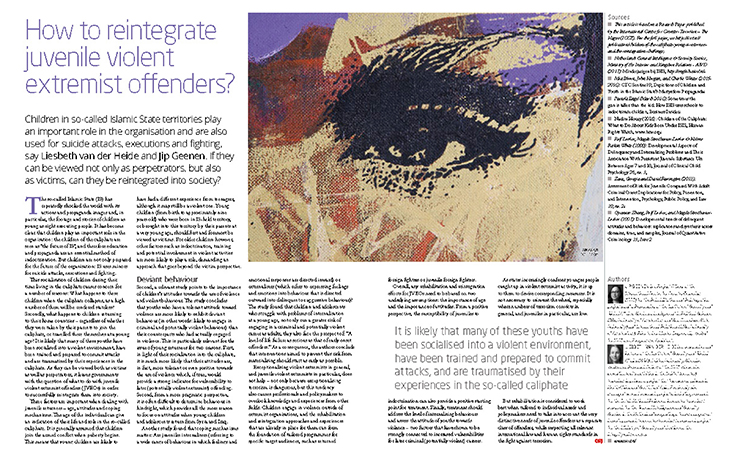
Liesbeth van der Heide and Jip Geenen tackle the issue of children who have lived in IS-controlled areas
Peacebuilding works but needs more support
Phil Vernon of International Alert knows that peacebuilding works, not just because he has been involved in it for over 20 years, but also because he has spent a considerable amount of time reading about successful initiatives while researching a report on the levels of support for, and engagement in, peacebuilding.
Preventing and surviving crisis
When she was 15, Alviina Almetsa lived through a school shooting at Jokela in Finland. The event led her to the world of crisis management, psychology and peace research. Here, she shares her thoughts on how communities can prevent crisis and, should one occur, how to survive with resilience.
Supporting those who flee Boko Haram
Being able to help fellow human beings is a privilege. To do this safely, we must embrace duty of care, says Editorial Advisory Panel Member Andrew B Brown, who outlines how personnel were kept safe during a fact-finding visit to speak to internally displaced people in Nigeria.
Employee assistance in an emergency
It is vital for companies – large and small – to put crisis plans in place in advance to ensure the safety and wellbeing of their employees, no matter where they are in the world, says Martin McLaughlin of Allianz Worldwide.
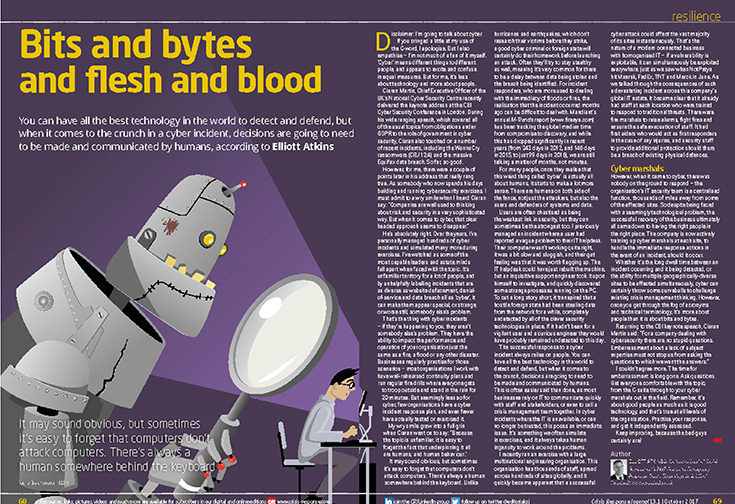
The human element in cyber security should never be overlooked, says Elliott Atkins
National resilience in times of crisis
David Stewart, Director of CRJ’s parent company Crisis Management Limited, analyses how one nation – Qatar – has demonstrated resilience during a crisis after its land border, sea routes and direct air flights were closed by a number of its neighbours.
Leadership qualities
It’s all well and good being a great leader in normal times, but what additional qualities are needed when crisis strikes? Rob McAlister, a Member of CRJ’s Editorial Advisory Panel, outlines the importance of sense-making, decision-making and communicating.
Battle boxes for business
It is time to bring the battle box into the 21st century to help with business continuity after a major incident, according to Christoph Schroth. Here is some advice as to what they should contain.

A look at emergency health communications by Ben Duncan
Bits and bytes and flesh and blood
You can have all the best technology in the world to detect and defend, but when it comes to the crunch in a cyber incident, decisions are going to be made and communicated by humans, according to Elliott Atkins.
The right risk communication saves lives
Ben Duncan highlights examples where risk communication in health emergencies has gone wrong, pointing out that this is not just a public relations problem, as it can undermine the overall response strategy and lead to more lives being lost.
Changing the landscape of emergency medicine and crisis response?
Millions of people, including emergency responders and military personnel, are at risk from traumatic brain injury, which can have devastating and enduring consequences. Our R&D writers – Ian Bogdanowicz, Carly Esteves and Dr Ian Portelli, report on promising medical developments for such injuries, calling for further research into its potential.
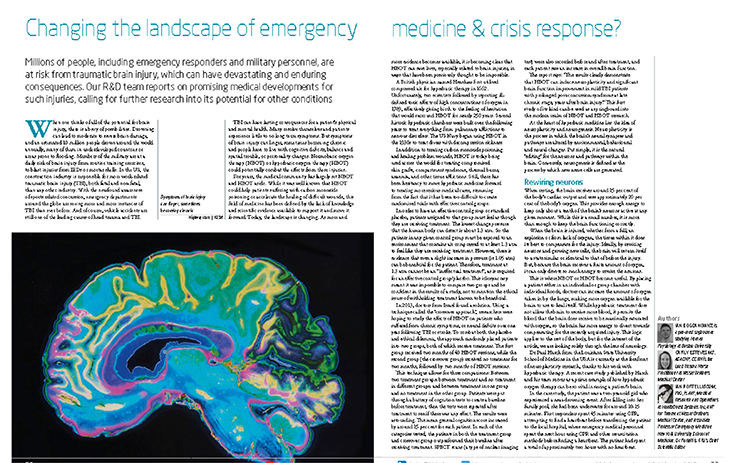
The field of hyperbaric oxygen therapy has done amazing things for medicine, adn could possibly change the landscape of emergency medicine and crisis response
An essential frontline poisons information resource
Timely access to advice on the features and management of poisoning is a crucial component of crisis preparedness; the UK National Poisons Information Service exists to provide this.
The constant honing of co-operation
The word ‘co-operation' is often used in a multiagency context, but what does it really mean? Bernard Wisniewski, Robert Socha and Tomasz Zweglinski explore this theme, using Poland’s’ fire and police services as an example.
Building safer societies: A framework for trust
Trust has to be earned. Here, Editorial Advisory Panel Member Laurence Marzell presents a scalable, transferable architecture for community policing, which is helping to build a bedrock of trust between citizens, law enforcement and other stakeholders.
Immersive counter-terror training
There has been a rise in the number of attacks carried out by lone operators, and an increasing number of attackers using vehicles and knives, writes Rob Munro. How can augmented and virtual reality training help?

Clean water for an entire nation – Darrel Larson explains how this will be achieved
Photogrammetry modelling using drones
Andreas Feichtner discusses issues related to drone-based photogrammetry to help with computer modelling.
Surface transportation as a second circle adopter
Nicholas B Hambridge, Arnold M Howitt (CRJ Editorial Advisory Panel Member) and David W Giles continue this series looking at the implementation of the National Incident Management System (NIMS) by analysing how far it has been adopted by transportation agencies in the United States.
Early warning in small islands part 3
Marlon Clarke and Danielle Evanson conclude this three-part series on early warning by looking at what barriers exist to ultimate effectiveness, and presenting some solutions that could help to improve warning systems.
The starting point for peace
In this issue’s frontline interview, Emily Hough speaks to Jeremy Gilley, the driving force behind the International Day of Peace, which is observed on September 21 and is dedicated to the absence of war and violence.
Robert McAlister explores the qualities of crisis leadership